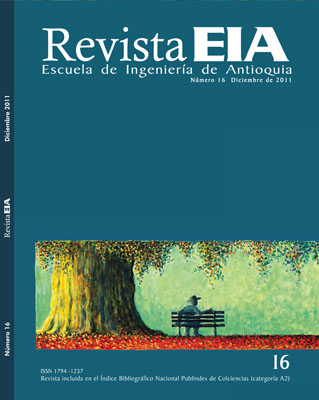INMUNOSENSOR PIEZOELÉCTRICO PARA LA DETECCIÓN DEL METABOLITO 3,5,6-TRICLORO-2-PIRIDINOL DEL PLAGUICIDA CLORPIRIFOS
INMUNOSENSOR PIEZOELÉCTRICO PARA LA DETECCIÓN DEL METABOLITO 3,5,6-TRICLORO-2-PIRIDINOL DEL PLAGUICIDA CLORPIRIFOS


This work is licensed under a Creative Commons Attribution-NonCommercial-NoDerivatives 4.0 International License.
Copyright statement
The authors exclusively assign to the Universidad EIA, with the power to assign to third parties, all the exploitation rights that derive from the works that are accepted for publication in the Revista EIA, as well as in any product derived from it and, in in particular, those of reproduction, distribution, public communication (including interactive making available) and transformation (including adaptation, modification and, where appropriate, translation), for all types of exploitation (by way of example and not limitation : in paper, electronic, online, computer or audiovisual format, as well as in any other format, even for promotional or advertising purposes and / or for the production of derivative products), for a worldwide territorial scope and for the entire duration of the rights provided for in the current published text of the Intellectual Property Law. This assignment will be made by the authors without the right to any type of remuneration or compensation.
Consequently, the author may not publish or disseminate the works that are selected for publication in the Revista EIA, neither totally nor partially, nor authorize their publication to third parties, without the prior express authorization, requested and granted in writing, from the Univeridad EIA.
Show authors biography
La detección y el seguimiento analítico del insecticida organofosforado clorpirifos son necesarios a fin de que sus niveles no sobrepasen los límites permitidos por diferentes normas de organismos reguladores. En este
trabajo se presenta un inmunosensor piezoeléctrico que puede determinar y cuantificar el 3,5,6-tricloro-2-piridinol (TCP), el principal metabolito del clorpirifos y del herbicida triclopir. El análisis y cuantificación del TCP se basa en un inmunoensayo competitivo con anticuerpo monoclonal. Para ello se inmovilizó, con enlace covalente, el conjugado de hapteno BSA-TS1 para TCP, sobre la superficie del electrodo de oro del cristal piezoeléctrico de cuarzo. Esta unión covalente a la superficie sensora se realizó mediante la formación de monocapas autoensambladas simples y mixtas (SAM y MSAM)). Se obtuvieron curvas patrón de calibración con cristales inmovilizados con ambos tipos, SAM y MSAM, y se compararon los resultados. Los valores de límite de detección (LOD) y el rango de trabajo obtenidos usando SAM simples fueron de 16 y 25-100 µg/L respectivamente, mientras que los valores obtenidos para estos dos parámetros empleando MSAM fueron de 9,5 y 18-74 µg/L respectivamente. En ambos casos, el cristal podía usarse alrededor de 100 ensayos sin pérdida apreciable de sensibilidad.
Abstract: Detection and monitoring of the organophosphate insecticide chlorpyrifos are required to comply with the limits allowed under different laws of regulatory agencies. Here we report on a piezoelectric immunosensor which can determine and quantify 3,5,6-trichloro-2-pyridinol (TCP), the main metabolite of chlorpyrifos and the herbicide triclopyr. The analysis and quantification of TCP is based on a competitive immunoassay with monoclonal antibody. Therefore, BSA-TS1hapten-conjugate for TCP was attached by a covalent bond to the gold electrode of a quartz crystal by means of both, simple and mixed self-assembled monolayers (SAM and MSAM). Standard calibration curves were obtained with both types, SAM and MSAM, and results were compared. For simple SAM the limit of detection (LOD) and working range obtained were 16 and 25-100 µg/L, respectively, whereas for MSAM were 9.5 and 18-74 µg/L, respectively. In both cases, the crystal may be used for about 100 tests without
appreciable loss of sensitivity.
Article visits 300 | PDF visits 127
